On View Now | Andy Warhol and the Anxiety of Effluence:
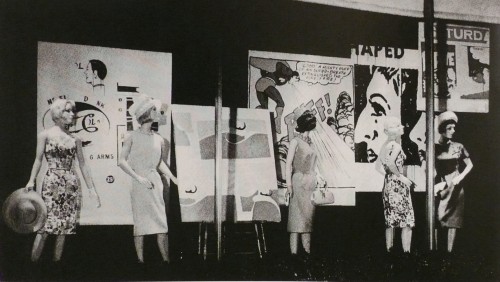
Andy Warhol’s window display at Bonwit Teller department store, 1961.
“In April 1961 Andy Warhol exhibited five large paintings in the window of Bonwit Teller, a New York department store where he had been working for some time producing window displays. The paintings, which were based on comic strips and black-and-white newspaper advertisements and positioned behind mannequins wearing the latest fashions, marked a turning point in Warhol’s transition from a highly successful commercial illustrator to an iconic figure in the New York avant-garde. Through the lowbrow subject matter of his canvases and its collapsing of the distinction between the space of art and the space of commerce, Warhol’s Bonwit Teller window display in many ways announced the artist’s forthcoming assault on the form, content and production of mainstream art and on how we look at and understand art in the context of popular and consumerist culture. Warhol’s impact on the art world is in many ways the subject of the Metropolitan Museum of Art’s exhibition Regarding Warhol: Sixty Artists, Fifty Years, which aims to account for Warhol’s influence on other artists.
It is worth remembering that 1961 was a time when art was still interested in—and defined by—the profound and metaphysical ideas of New York School painting. It was a time when the ideas of the older generation held powerful sway; when craft, uniqueness, and the artistic genius of individual talent were still valued and fetishized by the cultural establishment despite the irreverent lampooning already underway by Jasper Johns, Robert Rauschenberg and Larry Rivers. Warhol (along with Johns, Rauschenberg, Roy Lichtenstein and other contemporaries) took up the commercial and the mundane at a time when the artistic and cultural establishment deemed them inauthentic subjects and corrupted art forms. Soon, art that reveled in the shallow surfaces of popular culture and drew its inspiration from the mass produced became a mainstay, driven by pop and youth cultures that were primed by a booming consumer culture to embrace them.
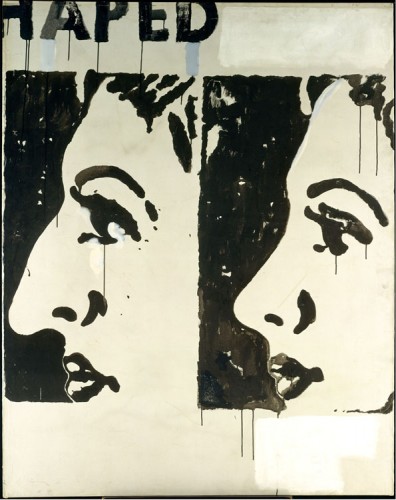
Andy Warhol, ‘Before and After I,’ 1961. Casein on canvas, 68 x 54 in. The Metropolitan Museum of Art, New York, Gift of Halston, 1981 (1981.536.1). © 2012 The Andy Warhol Foundation for the Visual Arts, Inc. / Artists Rights Society (ARS), New York.
The exhibition is divided into five thematic sections: ‘Daily News: From Banality to Disaster,’ ‘Portraiture: Celebrity and Power,’ ‘Queer Studies: Shifting Identities,’ ‘Consuming Images: Appropriation, Abstraction, and Seriality,’ and ‘No Boundaries: Business, Collaboration, and Spectacle.’ The first section visitors encounter is ‘Daily News: From Banality to Disaster,’ and in it one gets the sense early on of the challenges facing the curatorial task of accounting for Warhol’s nebulous legacy and the structural problems such an ambitious exhibition presents. In this section, Warhol’s iconic Brillo boxes, Campbell’s soup cans and his painting Before and After I, which was in the original window display at Bonwit Teller, are exhibited alongside a Damien Hirst pharmacy cabinet filled with empty bottles and boxes of prescription drugs, a bag of cat little made by Robert Gober, Jeff Koons’ pristine vacuum cleaners encased in Plexiglas and Hans Haacke’s enormous packet of cigarettes wielded as an indictment of then-Senator Jesse Helms and the tobacco industry for their hypocrisy.
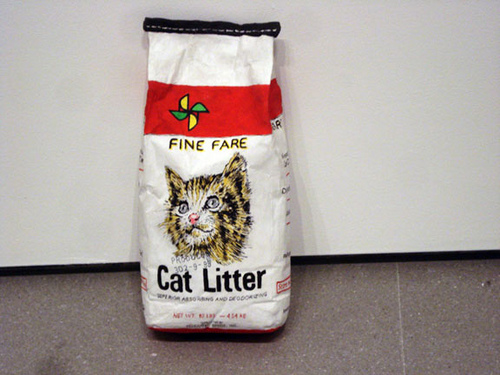
Robert Gober, ‘Cat Litter,’ 1990. Ink and latex paint on plaster 18½ x 11 x 5¼ in., edition 1 of 9. Courtesy Paula Cooper Gallery.
These later artists’ use of banal consumer goods clearly owes a debt to Warhol’s interest in the ordinary and the mass produced. But in an exhibition that ultimately asks us to consider Warhol’s enduring influence, the mere gathering of artworks referencing everyday objects doesn’t seem to be a compelling enough tie binding them together with Warhol’s practice. The most compelling elements of this later work—and how those elements connect to Warhol’s themes and draw upon his methods and strategies—remains largely unexcavated. How, for instance, does Robert Gober’s use of cat litter as an oblique symbol of the insidious notions of normalcy—sexual, social etc.—engendered by the domestic and puritanical rituals of American society relate to Warhol’s own probing of heteronormative culture? The accompanying wall text does explain Gober’s artistic intentions, but like the wall text throughout the exhibition it makes no effort to more deeply connect Gober’s politicized use of the banal to Warhol’s, beyond the shared interest in homoerotic subtexts.
Merely grouping together artists whose work variously reflect the influence of mass production on American art and culture—an influence that does trace back to Warhol, but not just to him as this show sometimes seems to imply—is fine, but it doesn’t clearly account for the more interesting aspects of Warhol’s influence. How, for instance, does Warhol’s work inspire Haacke’s overtly political art, or Hirst’s concern with such themes as perfection and mortality? How exactly is Koons’s use of household appliances to examine (and exploit) our habits of consumption, social desires and aspirations and the subtleties of marketing and the seduction of commodity display indebted to Warhol? The connections certainly exist but are not summoned forth, which is a lost opportunity.
This somewhat superficial approach to Warhol’s legacy also informs the exhibition’s next section, ‘Portraiture: Celebrity and Power,’ which positions Warhol as the father of the subsequent proliferation of artists exploring issues of fame and celebrity. Included here are some of Warhol’s most celebrated images of Marilyn, Jackie, Elvis and Joan, their recognizable names a testament to their iconic status in American popular culture. Contemporary celebrity portraits by Elizabeth Peyton and Karen Kilimnik are placed alongside them, as is a great photograph by Cindy Sherman of the artist posing as Marilyn Monroe.
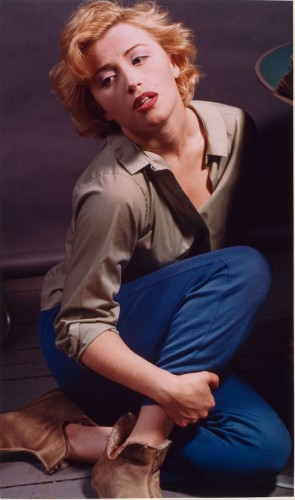
Cindy Sherman, ‘Untitled,’ 1982. Chromogenic print, ed. 43 of 125, 15 7/16 x 7 1/8 in. The Metropolitan Museum of Art, New York, Purchase, Eugene M. Schwartz Gift, 1983 (1983.1101). Courtesy of the artist and Metro Pictures, New York.
But ‘Portraiture: Celebrity and Power’ does little more than gesture to society’s continuing and obvious fascination with celebrity, ultimately failing to engage with what is perhaps Warhol’s most important contribution to art history, namely his examination of the concept and function of celebrity and its deeper relationship to the camera, mass media and the spectacular nature of consumer society. This is to say that the significance of Warhol’s artistic exploration of celebrity isn’t just in its straightforward appropriation of celebrities from popular and artistic sources, but in its role as feedback. Warhol’s work, like Sherman’s photographs, probes the familiar and the reminiscent latent in our cultural icons in ways that make us as viewers reflect upon our own preconceptions and our often-subconscious constructions of identities and their meanings. Warhol and Sherman don’t simply reflect back to us our own fascination with celebrities and the seductive power they wield, but rather reveal the authority and power relations that are baked into the technique and style of art and mass media, and which underpin our pop-cultural icons and the way we represent them. A deeper emphasis on such themes and how they intersect with Warhol’s own interest in desire (consumer, celebrity, sexual and psychological) would have made for more interesting juxtapositions and a more probing exhibition.
Ultimately, the sum of the show’s admittedly dazzling parts does not add up to a coherent whole. It isn’t that the sub-sections and sub-themes produce contradictory rhythms. The show is admirably kaleidoscopic in scope and in the varied artistic media and strategies presented, which is in itself an important part of Warhol’s legacy worthy of exploration. It’s more to say that such sub-groupings awkwardly circumscribe those broader lessons of his influence that defy easy categorization.
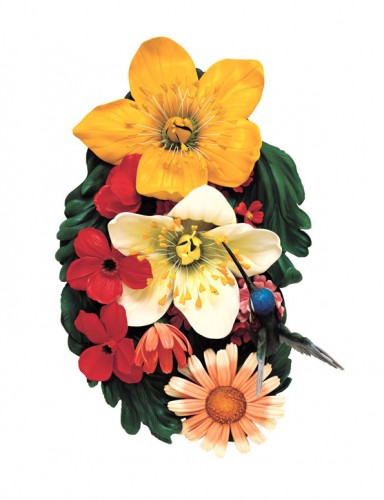
Jeff Koons, ‘Wall Relief with Bird,’ 1991. Polychromed wood, 72 x 50 x 27 in. Private collection. © Jeff Koons.
Art has always been an essential reflection of who we are, and Warhol’s demolition of the profundities and hyperbole of the art world he inherited—which effectively began with his window display at Bonwit Teller in 1961—was decisive. Indeed, one of Warhol’s greatest and most enduring legacies was his ability to simultaneously confront, critique, and, most tellingly, exploit the status, affluence and illusion that are the pillars of art and the art market and also of consumer culture. Warhol’s influence in many ways resists institutional historicizing and the organizational impulse of curatorial practice, both of which risk diminishing and oversimplifying Koons’ indebtedness to Warhol by simply juxtaposing Koon’s floral sculptures with Warhol’s flower paintings and effectively leaving it there. But alas, such a superficial reading that focuses on the seductive surfaces of the art in question at the expense of more complex relationships hidden beneath is an interpretation that Warhol probably would have appreciated and knowingly anticipated.
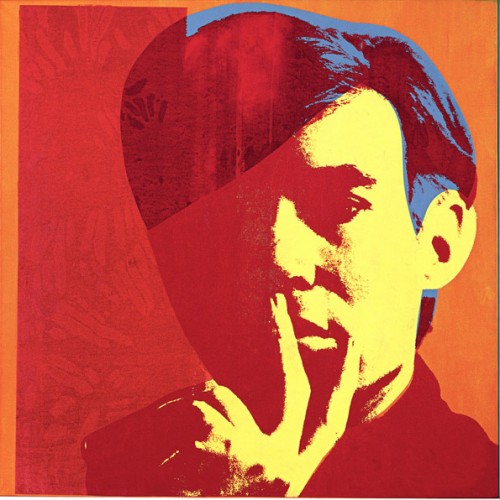
Andy Warhol, ‘Self-Portrait,’ 1967. Acrylic and silkscreen on canvas, 72 x 72 in. Detroit Institute of Arts, Founders Society Purchase, Friends of Modern Art Fund. © 2012 The Andy Warhol Foundation for the Visual Arts, Inc. / Artists Rights Society (ARS), New York.
Regarding Warhol: Sixty Artists, Fifty Years is on view at the Metropolitan Museum of Art in New York City through December 31, 2012.
‘On View Now | Andy Warhol and the Anxiety of Effluence’ originally appeared on the Art21 Blog
Subscribe to Art21 for mobile on Google Currents
(Via Art21 Blog.)
